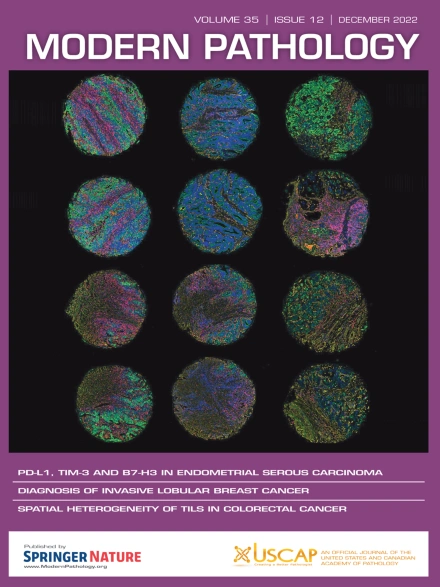Genomic Characteristics Related to Histology-Based Immune Features in Breast Cancer
IF 7.1
1区 医学
Q1 PATHOLOGY
引用次数: 0
Abstract
The immune cell component of the tumor microenvironment is an important modulator of tumor progression. In patients with breast cancer, tumor-infiltrating lymphocytes (TILs) and tertiary lymphoid structures (TLS) represent core aspects of antitumor immunity, both increasingly recognized for clinical relevance. In this study, we evaluated immune-related histology features using whole-slide hematoxylin and eosin (H&E) images of The Cancer Genome Atlas Breast Invasive Carcinoma (TCGA-BRCA) data set (n = 1035) and analyzed these distinct features relative to gene expression, PAM50 subtypes, and patient survival. H&E images were evaluated for TILs, plasma cells (PCs), high-endothelial venule-associated lymphoid aggregates (HALA), and mature TLS. For HALA and TLS, location relative to the tumor (nontumor, peritumor, and intratumor) was determined. HER2-enriched (HER2E) and basal-like breast tumors exhibited the highest mean TILs and the presence of PCs. HALA were present in 35.1% of cases and TLS in 6.5% of cases, also predominantly in HER2E and basal-like tumors. We derived gene expression signatures for 10 histologically defined immune features and tested their clinical significance using transcriptomic and survival data from the Sweden Cancerome Analysis Network – Breast (SCAN-B) cohort. Signatures related to TILs, PCs, HALA/TLS, TLS, and specifically intratumor HALA and TLS were associated with better survival in HER2E and basal-like tumors. Peritumor HALA/TLS and nontumor signatures were nonsignificant or associated with worse outcomes. Furthermore, we compared the immune microenvironment of high-TIL (TILs > 10%) tumors from TCGA-BRCA by PAM50 subtype through supervised analyses of 200+ immune gene expression signatures, and unique immune features were identified for each subtype. In high-TIL luminal tumors, enriched immune signatures had little relation to prognosis. High-TIL HER2E and basal-like tumors had distinct immune signatures linked to improved survival, related to B and T cells, respectively. Overall, PAM50 subtypes of breast cancer exhibit distinct immune microenvironments, both histologically and molecularly. These differences in immune properties should be considered when developing precise treatment strategies to achieve optimal therapeutic efficacy for patients.
与乳腺癌基于组织学的免疫特征相关的基因组特征。
肿瘤微环境中的免疫细胞成分是肿瘤进展的重要调节因子。在乳腺癌患者中,肿瘤浸润淋巴细胞(til)和三级淋巴结构(TLS)代表了抗肿瘤免疫的核心方面,两者越来越被认为具有临床相关性。在这项研究中,我们使用TCGA-BRCA数据集(n=1035)的全切片H&E图像评估了免疫相关的组织学特征,并分析了这些与基因表达、PAM50亚型和患者生存率相关的不同特征。对TILs、浆细胞(PCs)、高内皮小静脉相关淋巴细胞聚集体(HALA)和成熟TLS的H&E图像进行评估。对于HALA和TLS,确定相对于肿瘤的位置(非肿瘤、肿瘤周围和肿瘤内)。her2富集(HER2E)和基底样乳腺肿瘤表现出最高的平均TILs和pc的存在。35.1%的病例中存在HALA, 6.5%的病例中存在TLS,也主要发生在HER2E和基底样肿瘤中。我们获得了10个组织学上定义的免疫特征的基因表达特征,并使用来自SCAN-B队列的转录组学和生存数据测试了它们的临床意义。在HER2E和基底样肿瘤中,TILs、PCs、HALA/TLS、TLS,特别是肿瘤内HALA和TLS相关的特征与更好的生存率相关。肿瘤周围HALA/TLS和非肿瘤特征不显著或与较差的结果相关。此外,我们通过对200多个免疫基因表达特征的监督分析,比较了PAM50亚型TCGA-BRCA高til (TILs > 10%)肿瘤的免疫微环境,并确定了每个亚型的独特免疫特征。在高til管腔肿瘤中,免疫特征的富集与预后关系不大。高til HER2E和基底样肿瘤具有不同的免疫特征,分别与B细胞和T细胞相关,与生存率提高有关。总的来说,PAM50亚型乳腺癌在组织学和分子上都表现出不同的免疫微环境。在制定精确的治疗策略以达到最佳治疗效果时,应考虑这些免疫特性的差异。
本文章由计算机程序翻译,如有差异,请以英文原文为准。
求助全文
约1分钟内获得全文
求助全文
来源期刊

Modern Pathology
医学-病理学
CiteScore
14.30
自引率
2.70%
发文量
174
审稿时长
18 days
期刊介绍:
Modern Pathology, an international journal under the ownership of The United States & Canadian Academy of Pathology (USCAP), serves as an authoritative platform for publishing top-tier clinical and translational research studies in pathology.
Original manuscripts are the primary focus of Modern Pathology, complemented by impactful editorials, reviews, and practice guidelines covering all facets of precision diagnostics in human pathology. The journal's scope includes advancements in molecular diagnostics and genomic classifications of diseases, breakthroughs in immune-oncology, computational science, applied bioinformatics, and digital pathology.
 求助内容:
求助内容: 应助结果提醒方式:
应助结果提醒方式:


